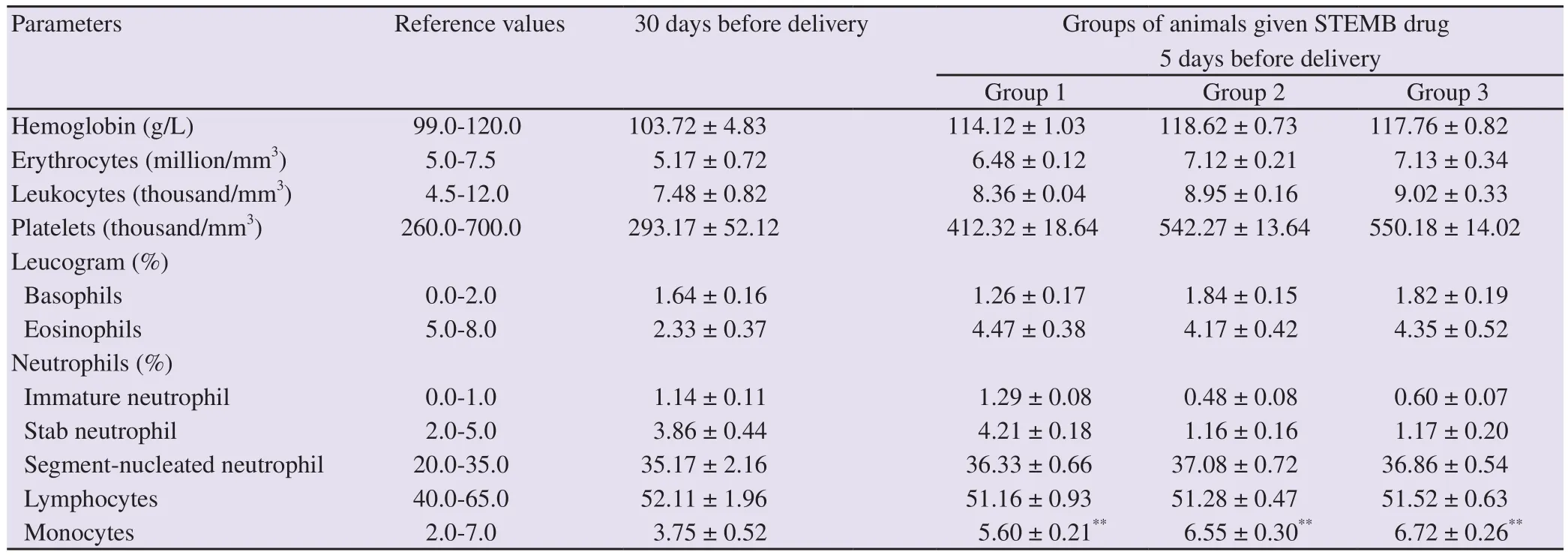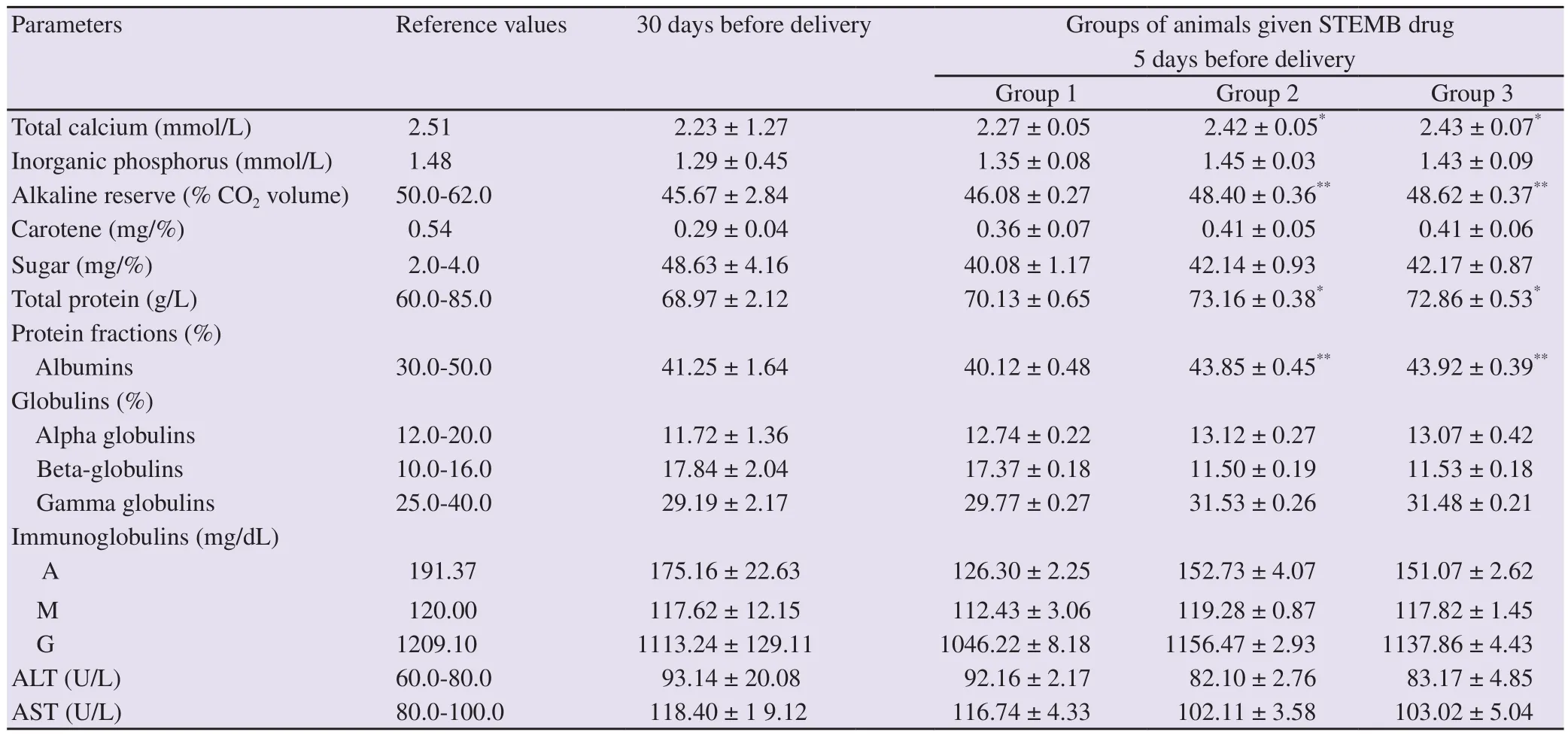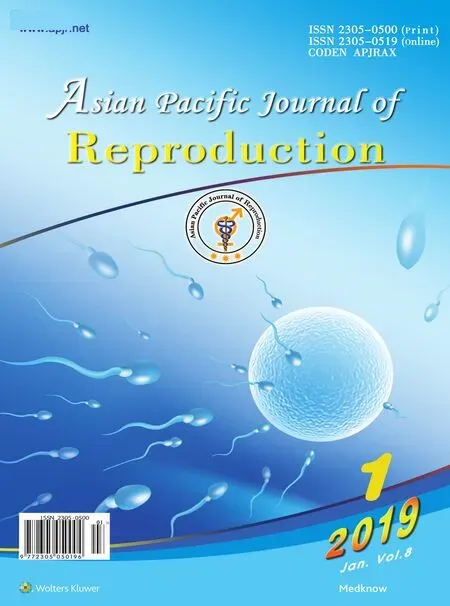Blood indicators of dry cows before and after administration of a drug STEMB
Murat H. Baimishev, Sergey P. Eremin, Khamidulla B. Baimishev, Svetlana A. Baimisheva
1Department of Anatomy, Obstetrics and Surgery, Samara State Agricultural Academy, Samara, Russia
2Department of Private Husbandry, Breeding of Farm Animals and Obstetrics, Nizhny Novgorod State Agricultural Academy, Nizhny Novgorod, Russia
Keywords:Drug STEMB Erythrocytes Hemoglobin Leukocytes Protein
ABSTRACT Objective: To determine the effect of a drug STEMB, which is a biostimulating tissue preparation based on chicken embryos, on the morpho-biochemical blood values of dry cows.Methods: The study was conducted on 60 Holstein cows, which were divided into three groups (group 1, group 2, and group 3), with 20 cows in each group. During the experiment, all animals in each group were subjected to the same condition of feeding and maintenance. The experimental animals were administered with the STEMB drug three times subcutaneously at an interval of 7 d within 30 d before calving. Group 1 were given 0.050 mL/kg body weight;group 2 were given 0.075 mL/kg body weight; group 3 were given 0.100 mL/kg body weight.Results: STEMB at 0.075 mL/kg body weight improved the blood cell composition, increasing the erythrocytes, hemoglobin, leukocytes, hemoglobin content, the total protein, albumins,alpha globulins, and gamma globulins. It reduced the beta-globulin index and provided a threshold level for the enzymes alanine aminotransferase, aspartate aminotransferase, and A,M, G immunoglobulins. Conclusions: Use of the STEMB drug with a dose of 0.075 mL/kg body weight given subcutaneously three times at an interval of 7 d within 30 d before delivery is optimal for the prevention of complications during calving and postpartum periods, thereby providing an improvement in the blood cell composition.
1. Introduction
An important link in elucidating the causes of decrease in fertility is the study of the morphological, biochemical composition of animal blood, in spite of the fact that it does not always provide an accurate picture of the state of metabolic processes in the body. It may be due to the presence of a complex integrating system which regulates the metabolic processes and the reproductive function.Many researchers now recommend that blood counts must be taken into account along with productivity when assessing reproductive ability of animals[1-4].
Morpho-biochemical changes in the blood of animals with postpartum endometritis are associated with intoxication of the body with products of inflammation occurring in the uterus. In such animals, the total protein content was found to be 4.1% higher than the values found in healthy animals[5].
This can be explained by an increase in the number of protein fractions of the injected endometrium inflammation. After recovery,there is a decrease in the amount of albumins and increase in the globulin fraction. Hormonal, antimicrobial, enzymatic preparations are used to correct the morpho-biochemical parameters of cows’blood before labor but recovery does not always occur to the level of a healthy animals. Also, there is no information in the literature on the correction of the hematologic parameters before labor which affects the periods of calving and postpartum[5-8].
Several studies have now led to the understanding that any pathology is the cause or consequence of hematologic disorders which contribute to the underlying disease. Also, the problem of correcting the function of reproduction in animals has not been solved completely and it is relevant till now[9-11].
In recent years, preparations from plant and animal origins have been widely used in order to increase the immune properties of the body so as to prevent disease occurrence and used in the treatment of genital pathologies in veterinary-medicine practice. In pursuant to this, there is the search for new drugs which have stimulating effect during the metabolic processes and that can normalize hematological parameters of blood. This is one of the main tasks in improving the preventive measures after calving especially in cows.
However, there is limited information on the use of the STEMB drug for the correction of the morpho-biochemical, immunobiological and the enzymatic blood values of cows during dry period.The duration of lactation more than 360 days adversely affects the development of the fetus due to metabolic disorders associated with high productivity of cows and the intensity of fetal growth. In this connection, it is necessary to develop an effective method for correcting the metabolic processes in cows in the second half of pregnancy.
2. Materials and methods
The research was conducted on 60 Holstein cows in the environment of the open joint stock company «NIVA» of the Samara Region of the Russian Federation. In the study, there were 3 groups(group 1, group 2, and group 3) of Holstein cows, with 20 heads in each group. All animals were in the drying-off period of 30 d.During the experiment, all animals in each group were under the same conditions of feeding and maintenance.
The STEMB drug was shaken and heated to room temperature before use. The drug was then injected into experimental animals subcutaneously through the neck area in 30 d before calving, given three times at an interval of 7 d. The administration of the STEMB agent was in three doses. Group 1 received 0.050 mL/kg body weight; group 2 were given 0.075 mL/kg body weight; group 3 were given 0.100 mL/kg body weight. To determine the dynamics of hematological parameters, blood samples were collected from the cows before administrated STEMB 30 d before calving and and the second blood collection was conducted 5 d before calving.
To determine the degree of influence of the STEMB drug on the morphological, biochemical and immuno-biological indicators,blood samples were first collected on day 30 before delivery and another on day 5 also before delivery, respectively. Morphological,biochemical and immuno-biological values of blood were determined in the hematological laboratory of the Federal State Budgetary Scientific Institution of Samara Scientific and Research Veterinary Station and in the blood laboratory of the Samara State Medical University. The blood parameters of the animals were determined by the following methods: hemoglobin – by hemiglobin cyanide method (Drabkin method) with the presence of readymade kits; erythrocytes and leukocytes – in the Goryaev chamber;leucogram – by differential calculation of leukocytes; total serum protein – by the refractometric method; serum protein fractions – by nephelometric method; glucose – by enzymatic colorimetric method;vitamin A in blood plasma – by Bessei’s pectrophotometric method;total lipids – by enzymatic and colorimetric methods using readymade sets “Vital”; immunoglobulins of classes G, A, M – taking into account the acoustic analyzer AKBa-01 “BIOM”.
All the digital material of the experimental data was processed by the method of variation statistics for the significance of the difference of the compared parameters using the Student’s criterion,adopted in biology and zootechnics, using MS Excel.
The study was approved by the Ethics Committee of the Samara State Agricultural Academy with the protocol No. 6, 15 June 2018.
3. Results
One of the main indicator characterizing the animal body condition was the blood value. Blood was the medium through which the tissues of the body received all substances necessary for their life activity. With the participation of blood, there was the removal of metabolic products from the cells, and it also determined the clinical medical body state of every living individual.
The comparative study of cows’ blood showed that the values obtained for the morphological parameters 30 days and 5 days before calving, were not the same, depending on the dose of STEMB.
The results for the morphological, biochemical parameters of cows given doses of STEMB drug within 30 days before calving showed large deviations among the experimental animals. From the results shown in Table 1, it was seen that the hemoglobin content of animals showed lower value which corresponded to the lower threshold(103.72±4.83) g/L. This was confirmed by the results obtained for erythrocytes, the amount of which was (5.17±0.72) million/mm3.This seemed to indicate a decrease in oxidation-reduction reactions in the body of the animals, which was due to the physiological stress of the cows’ body during prolonged lactation.
In the study 30 days before delivery, a decrease in the number of eosinophils by 2.67% which was relative to normal value indicated a decrease in the foreign proteins resulting to a decrease in the allergens; an increase in the content of immature neutrophils by 0.14% compared with the physiological normal value indicated a decrease in the activity of the cellular factor of the body’s defenses;the values of immunoglobulin’s A, M, G, in cows were less than the threshold value by 16.21, 2.38, 95.86 mg/dL, respectively, which indicated a biological pattern for pregnant animals.
Elevated levels of alanine aminotransferase (ALT) and aspartate aminotransferase (AST) in animal blood indicated an initial abnormality of liver function. Based on the conducted studies, it was found that after 30 days of the dry period, the blood counts of cows in terms of hemoglobin content, cellular composition and calcium,phosphorus, alkaline reserve gradients, globulin fractions, A, M, G immunoglobulins did not correspond to the threshold value, and the indicators characterizing the functional liver condition which were the ALT and AST also increased.
To know the effect of the STEMB doses on blood values and their validity, the hematological blood parameters were also analyzed 5 days before calving. In the course of the study, it was found that a triple injection of STEMB in a dose of 0.050; 0.075; 0.100 mL/kg body weight at an interval of 7 days had an uneven effect on the indicators of cows’ blood (Table 2).
For example, an increase in the hemoglobin, erythrocyte and leukocyte counts indicated a stimulating effect of the STEMB doses on the oxidation-reduction process and protective functions of the body.
The differential leukocyte count showed that the number of basophils and neutrophils increased, which indicated the manifestation of immunomodulatory properties of the stimulant.Also 5 days before calving, the platelets count in the cows of group 1 increased by 119.15 thousand/mm3compared to the value in the 30 days before calving. And the platelet count in the groups 2, 3 of cows respectively increased by 249.10 and 257.01 thousand/mm3compared to the values of 30 days before calving, which indicated an increased coagulation of the blood in these groups of animals.The results obtained indicated an increase in the platelets count in the blood of the cows before calving (Table 1).

Table 1 Morphological parameters of cows during 30 and 5 days before calving.

Table 2 Cows' blood chemistry values during 30 and 5 days before calving.
Based on the obtained data, it could be stated that the three-time STEMB administration at a doses of 0.075 mL/kg and 0.100 mL/kg body weight within 30 days before delivery improved the quality of the blood, increasing the hemoglobin, erythrocyte and leukocyte.Increase in the content of segment-nucleated neutrophils and monocytes indicated the activation of the body’s defenses of the animal organism due to the ability of the drug to stimulate the body vital functions as a result of changes in metabolic energy processes.Biochemical parameters of blood of cows in the experimental groups after three-time administration of STEMB preparation had differences depending on the dose of administration. The blood serum of cows of groups 2, 3 showed an decreased content of betaglobulins with a increased content of gamma globulins compared to group 1, which indicated a decrease in the protective properties of animals that were administered the drug STEMB in dose of 0.050 mL/kg body weight and apparently was one of the causes of postpartum pathologies.
Three-time administration of STEMB drug at a dose of 0.075 m/kg body weight within a 7 day period increased the content of immunoglobulin A by 26.430 mg/dL; immunoglobulin M by 6.850 mg/dL; immunoglobulin G by 110.250 mg/dL compared to the dose of 0.050 mL/kg body weight. The difference between the doses of STEMB administration at 0.075 and 0.100 mL/kg body weight was not significant and made 1.46 to 18.61 mg/dL for all classes of immunoglobulins, indicating an increase in the STEMB administration of the immune system of the body (Table 2).
The content of ALT and AST enzymes in the cows 30 days before delivery was 93.14 and 118.40 U/L, respectively, while 5 days before delivery, ALT and AST enzymes in groups 2, 3 were reduced to 82.10, 83.17, 102.11, 103.02 U/L, respectively, which practically corresponded to the normal value. ALT and AST enzymes in group 1 were insignificantly reduced by 0.98 and 1.66 U/L compared to the values of 30 days before calving (Table 2).
From these studies on morphological, biochemical and immunological blood values, results showed that the triple injection of STEMB at a dose of 0.075 mL/kg body weight given three times within 30 days before delivery increased the levels of hemoglobin,erythrocytes, leukocytes, gamma globulins in blood, improved the cellular composition of the blood by increasing the number of eosinophils, monocytes and segment-nucleated neutrophils with a decrease in the number of immature and stab neutrophil forms, betaglobulins. This was further accompanied by an increase in the M,G immunoglobulins level and an decrease in A immunoglobulin level in blood serum. The concentrations of ALT and AST enzymes in the blood were also reduced down to a threshold level 80.0, 100.0 U/L, respectively. This indicated that there was a normalization of the metabolic processes in the body of the experimental animals.
4. Discussion
During the study, the diet of animals was 120-130 MJ with a dry matter content of 44.95%. According to Giammarcoet al[7],when determining the optimal dosage of medication, there must be a favorable ratio of nutrients in the diet of cows. That is why an important link in understanding the causes of reproductive disorders is through the study of the biochemical blood composition of animals which provides an accurate picture of the metabolic processes in the body.
Use of STEMB medicine at a dose of 0.075 mL/kg body weight subcutaneously, given three times at an interval of 7 d in 30 d before delivery, significantly normalizes the metabolism of dry cows, as indicated by blood counts in 5 d before calving. The specified dose increased the amount of albumins, alpha and gamma globulins,total protein, and alkaline reserve with a decrease in beta globulins and sugar. The results obtained are consistent with the findings of Shatalina[12] and Gerardoet al[11]. They found that during late pregnancy in highly productive cows with prolonged lactation over 360 d, metabolic energy processes are broken which are manifested in a decrease in the number of segmented neutrophils, total protein,gamma globulins, monocytes; and it is one of the main etiological factors in the manifestation of postpartum pathologies[13-15].
For the first time, it was shown in an experiment that using the optimal dose of STEMB drug at a dose of 0.075 mL/kg body weight can normalize the morphological and biochemical blood indices of dry cows.
Pursuant thereto the broad-spectrum STEMB preparation can be recommended for use in the prenatal period for the correction of metabolic processes of blood indicators at a dose of 0.075 mL/kg body weight, subcutaneously given three times at intervals of 7 d in 30 d before delivery.
In conclusion, the STEMB agent dosage of 0.075 mL/kg body weight subcutaneously given three times at an interval of 7 d within 30 d before delivery has a better effect on the blood cell composition compared with the doses of 0.050 mL body weight. This dosage increases the erythrocyte count up to 7.12 million/mm3, segmentnucleated neutrophils up to 37.08%, hemoglobin up to 118.62 g/L,total protein up to 73.16 g/L, alkaline reserve up to 48.40% CO2,gamma globulins up to 31.53%, decreases beta-globulins down to 11.50%, and also optimizes the content of immunoglobulins A, M,G at 152.73, 119.28, 1156.47 mg/dL, respectively, and the enzymes ALT at 82.10 U/L, AST at 102.11 U/L, in comparison with doses of 0.050 mL/kg body weight. The values obtained by STEMB agent dosage of 0.100 mL/kg were similar to the values obtained at dosage of 0.075 mL/kg, and therefore the lowest dose can be considered the most rational for practical application. Hence, the dosage of STEMB agent can be used for prevention of parturient and postpartum complications at a dose of 0.075 mL/kg body weight, three times,subcutaneously at intervals of 7 d in 30 d before delivery.
The study result is a contribution to the world and domestic science in veterinary obstetrics and hematology for high-producing cows. This is because it will allow methods to be developed for the STEMB drug use, taking into account the age and sex of animals,breeds, the level of milk production and the dry matter content in the diet. The data obtained supplement information on the blood values of cattle, depending on the breed and physiological state.
In the course of subsequent research, methods for improvement of efficiency of post-parturient complication prevention in highproducing cows using STEMB should be developed, and the effect of STEMB on the morphofunctional status of newborn calves should also be studied.
Conflict of interest statement
All the authors declare that there is no conflict of interest.
 Asian Pacific Journal of Reproduction2019年1期
Asian Pacific Journal of Reproduction2019年1期
- Asian Pacific Journal of Reproduction的其它文章
- Infertility in China: Culture, society and a need for fertility counselling
- Total segmental aplasia of uterus body in bitch
- Chronic atrophic endometritis and pyometra in a ferret: A case report
- Comparison of transvaginal cervical length and modified Bishop’s score as predictors for labor induction in nulliparous women
- Value of α-fetoprotein,β-HCG, inhibin A, and UE3 at second trimester for early screening of preeclampsia
- Effect of butylated hydroxytoluene on quality of pre-frozen and frozen buffalo semen
